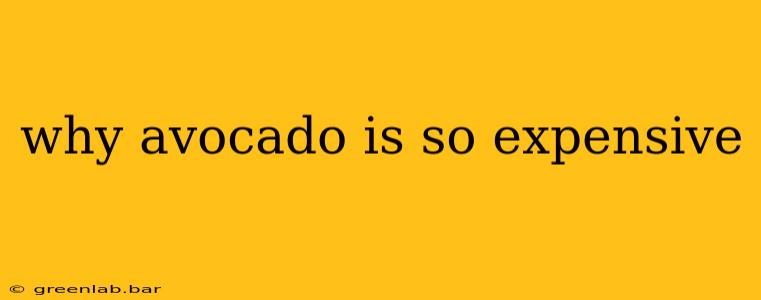Avocados. Creamy, healthy, and versatile, they've become a staple in kitchens worldwide. But their popularity comes at a price—literally. Why are avocados so expensive, and what factors contribute to their fluctuating cost? Let's dive into the complex economics of this beloved fruit.
The Impact of Supply and Demand
The most significant factor influencing avocado prices is the simple interplay of supply and demand. When demand surges, particularly in regions with high consumption like North America and Europe, and the supply fails to keep pace, prices inevitably rise. This is often exacerbated by seasonal variations in avocado production.
Seasonal Fluctuations: A Major Player
Avocado trees don't produce fruit year-round. Harvest seasons vary depending on the growing region, leading to periods of abundance and scarcity. When a particular region's harvest is low, global supply diminishes, pushing prices upward. This seasonal variability significantly impacts market prices, creating peaks and troughs throughout the year.
Growing Demand Outpacing Supply
The global demand for avocados has exploded in recent years. Fueled by health trends, social media influence, and increased awareness of their nutritional benefits, consumption has far outpaced the ability of producers to meet this demand. This imbalance between supply and demand is a primary driver of high prices.
Beyond Supply and Demand: Other Contributing Factors
While supply and demand are crucial, several other factors contribute to the relatively high cost of avocados:
Production Costs: From Farm to Table
Cultivating avocados isn't cheap. The process requires significant investment in land, water, labor, and pest control. Avocados are also relatively labor-intensive to harvest, further adding to the overall production costs.
Transportation and Distribution: A Global Journey
Avocados are often transported long distances from producing countries to consumer markets. This transportation adds considerable cost, especially given the need for temperature-controlled shipping to maintain freshness. Furthermore, tariffs and import duties can add substantial expense, particularly in international trade.
Market Speculation and Price Manipulation
While less readily apparent, market speculation can play a role in price fluctuations. Large-scale buyers and traders can influence market prices through speculative trading, potentially driving prices up even beyond what is justified by supply and demand alone.
Climate Change and Environmental Impacts
Climate change is increasingly impacting avocado production. Changes in rainfall patterns, extreme weather events, and shifting temperature zones can negatively affect crop yields, leading to reduced supply and consequently, higher prices. Sustainable farming practices are crucial to mitigate these impacts, though they may involve increased upfront costs.
The Future of Avocado Prices
Predicting future avocado prices is challenging, but several factors suggest continued price volatility. Sustained high demand, coupled with potential supply disruptions due to environmental factors, indicates that avocados may remain a relatively expensive fruit for the foreseeable future. However, advancements in farming techniques, improved distribution networks, and increased cultivation in new regions might eventually help to moderate prices over the long term.
Conclusion: The high cost of avocados is a result of a complex interplay of factors, from seasonal availability and global demand to production costs and logistical challenges. Understanding these factors helps to appreciate the journey of this popular fruit from farm to table and shed light on why its price often leaves consumers reaching for their wallets.

